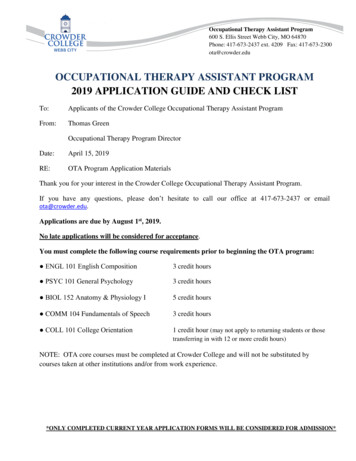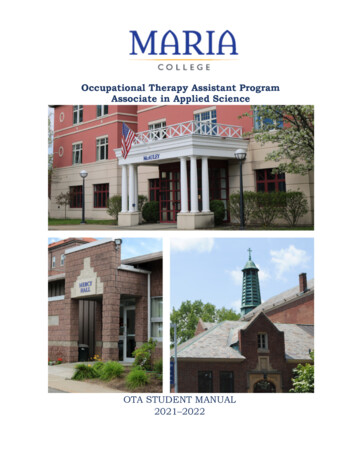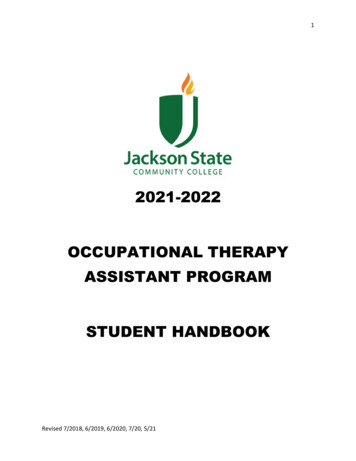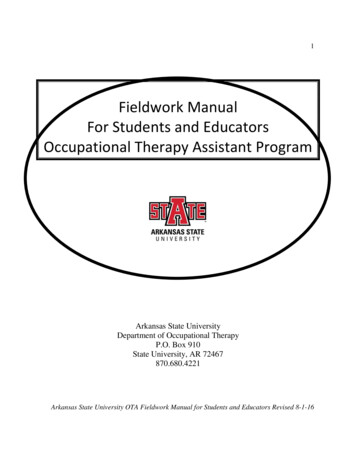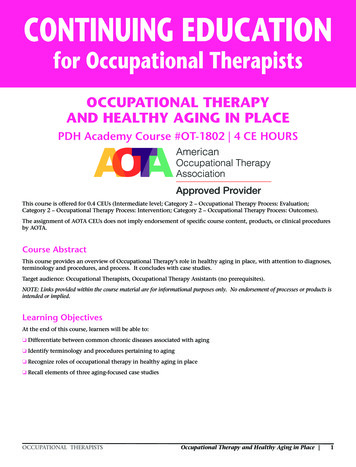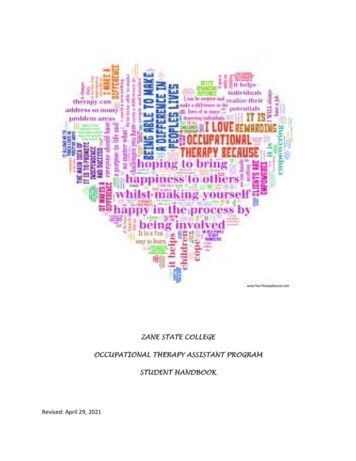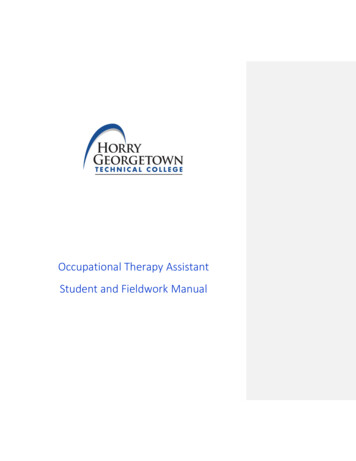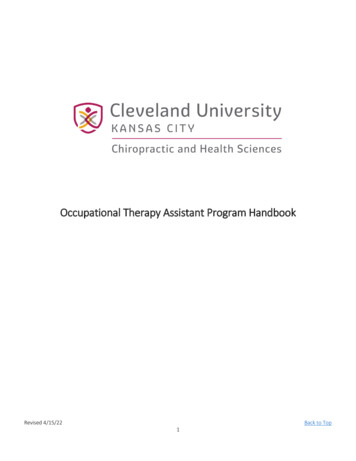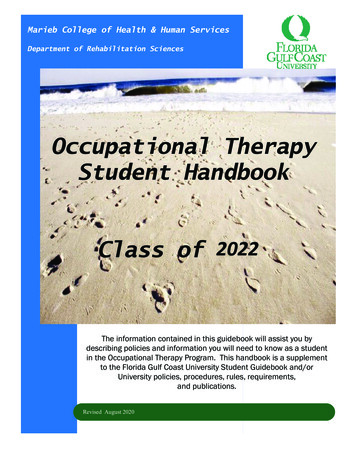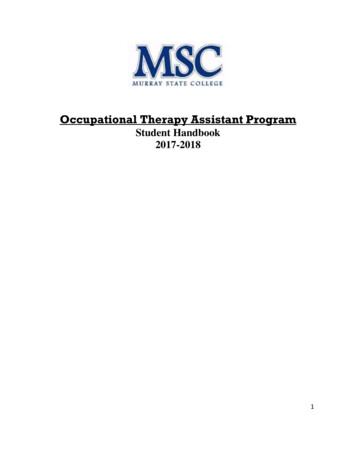
Transcription
Occupational Therapy Assistant ProgramStudent Handbook2017-20181
Welcome to Students at MSC OTA ProgramDear Student,Welcome!On behalf of the entire faculty and staff of the OTA Program at Murray State College, I congratulateyou on pursuing an exciting and fulfilling career in the field of occupational therapy! You areembarking into one of the most sought-after, highly in demand, and rewarding jobs in health care.Occupational Therapy is a life-long endeavor that provides the opportunity to invest in the lives ofthose around you.As you learn and grow in this challenging program, you will immerse yourself with the knowledge,skills, and concepts in Occupational Therapy practice. You will have preparation and training inboth academic and clinical/fieldwork components. This program, along with your personalmotivation and efforts, will help you prepare to be the best Occupational Therapy Assistant that youcan be upon entry-level practice.This student handbook is a guide designed and developed to make you aware of the MSC OTAProgram’s rules and regulations, as well as the general student policies and procedures at MurrayState College. I strongly advise you to read this thoroughly, understand it, and comply with it. Thiswill help you remain steadfast in fulfilling your part as a student in our program and at MSC.Once again, I welcome you and it is a pleasure to share this learning experience with you!Sincerely,Dr. Jayne Campanini, OTD, OTR/LOTA Program DirectorMurray State College2
Table of ContentsSection IOverview of the Occupational Therapy Assistant Program2345671010121416192021Section IINew Student WelcomeTable of ContentsGeneral Information and Accreditation StatementProgram Description & PurposeOTA Program Student Learning Outcomes and Curriculum ThreadsDomains of LearningClinical Fieldwork EducationOTA Program CurriculumOTA Program Course DescriptionProfessional BehaviorsEssential Functions of the OTAHealth Science Department Roster - Faculty and StaffHealth Science Administration Organizational ional Therapy Assistant Program PoliciesOTA Admission and Progression PoliciesOTA Program Academic PoliciesClassroom Attendance PolicyFieldwork Attendance PolicyInclement Weather PolicyMethods of Evaluation of Student LearningStudent Educational Rights –FERPARelease of Student Information & Patient Rights-HIPAADress CodeReadmission PolicyGrade AppealsOSBMLS, NBCOT, OKOTA, AOTACommittees and Student OrganizationsSection IIIPolicies and ProceduresForms3
SECTION IGENERAL INFORMATIONMission of the Murray State College Occupational Therapy Assistant ProgramThe Murray State College OTA program prepares competent, Occupational Therapy Assistantswho support participation in daily life pursuits to improve the quality of life and health ofclients in south central Oklahoma. The program is designed to prepare graduates to beeffective providers of occupational therapy services within a healthcare team and under thedirection of an occupational therapist and to act as responsible members of the profession.Purpose of HandbookThe OTA Program Student Handbook is a guide for students in finding the answers to commonquestions pertaining to the program. Students are responsible in reading and understanding all theinformation in the Handbook. Students who claim to be unaware of a policy are not excused fromcomplying with the policy. Students should request clarification as soon as possible if any portionis unclear. After reading the Student Handbook, all students are required to sign the last page andreturn it to the OTA Program Director by the end of the first day of class.Each student is responsible for compliance with the information in this Handbook. TheOccupational Therapy Assistant Program reserves the right to change policy and regulations asdeemed necessary. The students will receive notice should changes occur.Accreditation StatementThe occupational therapy assistant program is accredited by the Accreditation Council forOccupational Therapy Education (ACOTE) of the American Occupational Therapy Association(AOTA) located at 4720 Montgomery Lane, Suite 200, Bethesda, MD 20814-3449. ACOTE’stelephone number c/o AOTA is (301) 652-AOTA and its web address is www.acoteonline.org.An occupational therapy assistant program must be accredited by the AOTA’s Accreditation Councilfor Occupational Therapy Education (ACOTE) prior to students’ graduation for its students to beeligible to sit for the national certification examination offered by the National Board forCertification in Occupational Therapy (NBCOT) at www.nbcot.org. Applicants for certificationtesting with the NBCOT and subsequently for licensure in the state of Oklahoma (or state of choice)must meet all requirements to hold an Oklahoma license (or license in state of choice) to practice asan occupational therapy assistant. In addition, a felony charge or conviction may affect thegraduate’s ability to take the NBCOT Examination and to apply for state licensure. All studentsmust complete the Level II fieldwork experiences within 12 months following completion of thedidactic coursework of the OTA program and prior to registering for and taking the NBCOT exam.4
PROGRAM DESCRIPTIONThe Occupational Therapy Assistant Program offered at Murray State College (MSC) leads to anAssociate in Applied Science (A.A.S) Degree. The Associate in Applied Science degree program atMSC is a “1 1” model program. The first portion of the program consists of 34 credit hours ofprerequisites and the second portion consists of 35 credit hours of specialized occupational therapyassistant courses only available to students after formal acceptance into the program.At Murray State College, the Occupational Therapy Assistant program prepares the student, “todeliver occupational therapy services under the supervision of and in partnership with theoccupational therapist” (AOTA, 2005 Scope of Practice) and to uphold the core values and attitudesof occupational therapy practice (AOTA, 1993 Core Values and Attitudes). Effective occupationaltherapy service delivery involves a collaborative relationship between the supervising occupationaltherapist and the occupational therapy assistant using a client-centered approach with the personserved and their family. The graduate will articulate the role and responsibility of the occupationaltherapist and the occupational therapy assistant in the supervisory process and be prepared touphold the ethics, standards, values, and attitudes of the occupational therapy profession.A.A.S. degree program graduates are prepared to take the nationally prepared certificationexamination through the National Board for Certification in Occupational Therapy (NBCOT).Following successful completion of the national certification examination, the graduate may enterthe profession of occupational therapy and provide client-centered occupational therapy servicesunder the direction and supervision of a qualified occupational therapist. Most states includingOklahoma and Texas require a license to practice as an Occupational Therapy Assistant. A studentmay apply for state licensure after receiving a passing score on the NBCOT examination.PurposeThe program aims to meet the needs of prospective students and the surrounding community, witha focus on regional health care providers in the 10-county service area of the college. The OTAprogram provides students an effective learning environment in the classroom, laboratory, andfieldwork, and offers student support services, faculty guidance, and current occupational therapyresources. The program prepares its graduates to be effective providers of occupational therapyservices as competent generalists within a healthcare or educational team, under the supervision ofan occupational therapist and to act as responsible members of the profession.The Philosophy of MSC OTA ProgramThe philosophy of MSC OTA program is a developmental approach based on the Philosophy ofOccupational Therapy Education. “Education promotes clinical reasoning and integration of professionalvalues, theories, evidence, ethics and skills” (AOTA, 2014). While participating in the MSC OTAprogram, students then learn to critically analyze, evaluate and create their own ideas through variousprojects, case studies and self-reflections within specific courses and throughout the curriculum.Students engage in individual and group projects, hands on activities, demonstrations, simulatedlaboratory activities, and case study presentations using an active learning methodology. The design ofthe curriculum embraces the philosophy of applying information used in previous or simultaneous courses5
and evidence based research for critical analyzes of material for efficient evaluation of new situations forproper planning of intervention. This design allows future occupational therapy assistants “acollaborative process that builds on prior knowledge and experience [while promoting] continuousprofessional judgement, evaluation and self-reflection and lifelong learning” (AOTA, 2014).ReferenceAmerican Occupational Therapy Association. (2014). The philosophy of occupational therapy education.Retrieved from lbase2014.pdfNature of LearningLearning is an active process. Content learning starts with simple and concrete and builds tocomplex and abstract. Learners first acquire facts, develop concepts, organize into principles, andthen problem solve. Learners have unique knowledge, experiences, and ways of learning. Learningoccurs in an upward, circular, variable progression through uneven stages and steps. Organizationof learning occurs when students are actively engaged in making sense of information within aknown or meaningful pattern or personal context. The learner must first have the right attitude,self-motivation, and appropriate behavior to make the learning experience positive and beneficialto the learner.OTA PROGRAM STUDENT LEARNING OUTCOMES AND CURRICULUM CONTENT THREADSA student/graduate of the OTA program at Murray State College will achieve the followingoutcomes in each of five areas: knowledge, critical reasoning, interpersonal skills, performanceskills, and ethical reasoning.Student Learning Outcomes:A student/graduate of the OTA program atMurray State College will achieve the followingoutcomes in each of five areas: knowledge,ethical reasoning, performance skills,interpersonal skills and critical reasoning.Knowledge The student will satisfactorily completethe didactic and fieldwork components ofthe program. The graduate will satisfactorily pass thenational certification board exam foroccupational therapy assistant. The graduate will keep current with bestpractice and practice life-long learning.Curriculum Threads:General content areas or threads runthroughout the Occupational TherapyAssistant Program and reflect student learningoutcomes.Ethical Reasoning The student/graduate will uphold theethical standards, values, and attitudes ofEthical and professional behavior regardingjudgement, core values, commitment to the codeof ethics and standards of practice.Basic knowledge on client centered;occupationally and contextually relevantinterventions; and health and wellness,6
the occupational therapy profession.Performance Skills The student will satisfactorily employoccupational therapy principles tocomplete assessment tools, developintervention through gradedpresentations/demonstrations, simulatedtreatment activities, lab practical exams,and other student evaluation methods. The graduate will employ occupationaltherapy principles to complete assessmenttools and interventions as an entry levelpractitioner under the direction of theOccupational Therapist.Apply and analyze occupational therapyprinciples to complete assessment tools andclient-centered interventions.Interpersonal Skills The student/graduate will demonstrateaccurate, conscientious, and effectivecommunication skills to ensure qualitycare.Communication skills reflecting written, verbal,and non-verbal using appropriate client-centeredcommunication styles developed through selfexploration and understanding.Critical Reasoning The student/graduate will establishcritical thinking and professionalreasoning skills necessary to achieveexpected treatment plan outcomes andprovide discharge recommendations asrelated to occupation.Evaluate occupational therapy principles andclient needs using narrative, pragmatic, ethicaland scientific reasoning to create client specificinterventions, discharge recommendations andhealth/wellness visions.DOMAINS OF LEARNINGThe program’s faculty believes that professional occupational therapy education is a dynamicprocess. Learners have unique prior experiences and knowledge that are inherently valuable andserve as the basis for the development of new knowledge, skills, and attitudes. These types oflearning can be conceptualized using three domains of learning identified in Benjamin Bloom’sTaxonomies of Learning.Learning knowledge, skills, and abilities occurs in three domains, of equal importance and value inprofessional education, which are addressed throughout the curriculum: Affective domain: This domain includes how we deal with things on an emotional orfeeling level: values, attitudes, motivations, enthusiasms, and emotions. Students bring withthem inherent beliefs developed through unique life experiences. The program curriculum,academic and clinical faculty will guide students through a process of self-awareness,7
valuing, and internalization of the core values of the profession helping to shape theirprofessional and personal development and elicit commitment to the ideals of theoccupational therapy profession. Evaluation of this domain will take place by the student,academic and clinical faculty using a variety of methods including journaling, written andverbal responses to clinical problems, self-assessment, small group and electronicdiscussions, and behavioral and skills evaluations. Psychomotor domain: Cognitive domain:This area involves knowledge, comprehension, analysis, and evaluation. This domaininvolves six level or layers: remembering, understanding, applying, analyzing, evaluating,and creating. It is conceptualized as a prism that shows hierarchy with each layer a morecomplex one toward the top as seen in Table 3, p. 10. Growth starts at the bottom or simplelayer, remembering, and advances through the top more complex layers, evaluating andcreating. As students learn new information, they will begin again at remembering andexpand through the levels by means of incorporation and integration of new and oldlearning. Progression of learning through levels is a constant layering process with theaccumulation of personal meaning and relevance; conceptualized as the filling between thelayers, from the affective domain. This is crucial to intellectual development and the abilityof the student to master core content required of the occupational therapy assistant andcritical to developing clinical reasoning. The academic and clinical instructors evaluate thestudent in this domain through but not limited to case studies, classroom simulation,documentation practice, examinations, projects, presentations, class discussions, electronic(blackboard) posts, and application in clinical/fieldwork situations.The physical movement, coordination, and motor skill required to accomplish treatmentinterventions, patient teaching, and assessments provided by the occupational therapyassistant are an important part of learning. Since some students learn best through doing,the faculty will incorporate “doing” or psychomotor learning to optimize and reinforcelearning in the cognitive domain. The learning “by doing” approach will be appliedthroughout the curriculum to facilitate learning in all domains. Student performance ofpractical skills in the occupational therapy skills labs, OTA classes, and during the fieldworkcomponent of the curriculum is to evaluate skill development in motor learning in thepsychomotor domain.Spiritual and perceptual domainsAdditionally, learning activities will occur in spiritual and perceptual areas, which areconsidered domains of learning by some educators. These domains are not well classifiedor defined in steps as are the other three. The OTA faculty believes that learning in theperceptual domain overlaps with and can be evaluated through performance in thepsychomotor domain. Unique to Occupational Therapy theory is inclusion of a spiritualdomain, i.e., a Spiritual Context, defined as, “the fundamental orientation of a person’s life;that which inspires and motivates the individual” (AOTA, 2002 Occupational TherapyPractice Framework.) Thus, exploration of beliefs, values, motivation, life meaning, selfreflection, and understanding of the spiritual context will be included. Students will beguided and encouraged to explore this domain, but will not be specifically evaluated by theprogram’s faculty.8
Source: http://www.odu.edu/educ/llschult/blooms taxonomy.htmNew Version of Bloom’s Taxonomy of LearningRemembering: Can the student recall or remember the information?Understanding: Can the student explain ideas or conceptsApplying: Can the student use the information in a new way?Analyzing: Can the student distinguish between the different parts?Evaluating: Can the student justify a stand or decision?Creating: Can the student create new product or point of view?In order to complete the program successfully, each student must show satisfactory progress in each ofthe above domains of learning.Healthcare InformaticsAnother important area of learning is in the field of medical informatics, or healthcare informatics.Healthcare professionals must competently participate in current technology in the virtual contextincluding electronic medical records, electronic healthcare information systems, electronic patientand data processing, and internet-based medical and consumer informatics. Healthcare informaticsincludes the use of health information technology to improve patient care, improve the quality, andincrease the efficiency of health care delivery.“Healthcare Informatics is defined generally as understanding the meaning, relationships andproperties of health care information as a basis for biomedical knowledge discovery, informationretrieval, storage and dissemination for purposes of supporting the process and evaluation of healthcare of the public and content to future health professionals. “ (Web information from KU Center forHealthcare Informatics, www. kumc.edu)Understanding the effective use of electronic or virtual technology for student and professionallearning is indispensable for healthcare professionals to make best use of a wide array of electronicmedical information systems and communications technology. Murray State College OTA studentswill participate in healthcare informatics. Students are required to become effective at accessingonline resources and using technology to communicate with classmates and faculty. Mostassignments are turned in using online technology, and access to online resources outside of class is9
required. Murray State College recognizes the value of technology in education and providesresources to meet the needs of students and faculty.CLINICAL/FIELDWORK EDUCATIONClinical experiences are designed to meet the needs of the student. These experiences are basedupon OT theory and current OT practice. Qualified fieldwork educators (FWE) supervise OTAfieldwork students from approved facilities utilized for fieldwork education experiences. Thesefacilities are selected primarily from various locations in the service area of Murray State College.However, student convenience does not take priority over educational need. When a student canbenefit from a specific clinical site that requires extended travel, then the student must arrange tocomplete any assigned fieldwork experience. Students take part in the identification of needed anddesired fieldwork experiences through advisement with the Academic Fieldwork Coordinator.While students participate in the process and are encouraged to help with the development of newfieldwork sites in areas where they may have family or friends whom to stay with, the facultyultimately determines the fieldwork site location that each student will complete as part of thefieldwork education component of the program. Close geographical proximity is not guaranteed.Students can expect to drive, with the student’s own transportation means or arrangement, up to anhour and a half each way, or to make personal arrangement for lodging in a more distant location.Each student has a Student Fieldwork Manual provided at the pre-fieldwork seminar. Each studentwill also have, in hardcopy and/or in electronic format, a schedule of activities, requiredassignments, and required forms to complete in the fieldwork experience.The MSC OTA fieldwork education portion of the curriculum consists of Level I and Level IIexperiences. Level I experiences are scheduled during the didactic portion of the curriculum. LevelII experiences consist of two eight-week rotations of full-time fieldwork experiences that occurafter successful completion of 29 credit hours of required specialized coursework. Level IIexperiences are generally Mondays thru Fridays from 8 o’clock to 5 o’clock. Some sites also offervariations on scheduling depending on the fieldwork educator’s schedule, such as 4-10 hour days, 4and ½ days, or 3-12 hour days followed by 4 days off, etc.OCCUPATIONAL THERAPY ASSISTANT PROGRAM CURRICULUMMISSION of Murray State CollegeThe mission of the college states:Murray State College Provides Opportunities for Student Learning, Personal Growth, ProfessionalSuccess, and Community Enhancement.The OTA program supports this mission and OTA students have the same rights, privileges, andobligations as other Murray State College students and are encouraged to participate in college life.A graduate from Murray State College will have achieved several key outcomes resulting from theeducation process. The OTA program supports and builds upon student success through theattainment of the following: Effective Communication Students will demonstrate effective communication skills necessary for daily interaction in10
society and the workplace Responsible Citizenship Students will demonstrate an awareness of social and civic responsibilities. Global Awareness Students will demonstrate an awareness and acceptance of cultural diversities and thehumanities. Critical Thinking Students will demonstrate problem-solving and critical thinking skills necessary forpersonal and professional success. Quantitative Reasoning Students will demonstrate quantitative reasoning skills by performing mathematical andscientific computations common to various technical fields. Information Literacy Students will demonstrate and apply information literacy skills and utilize technologicalresources necessary for personal and professional success.General Education Requirement – 1st yearMurray State College’s curriculum provides the general education needed to produce literate,informed, and involved citizens. It provides training in written and oral communication skills,critical thinking, and knowledge about the history and political system of the United States, and ofworld culture. It exposes the student to literature, and to the visual and performing arts. It groundsstudents in the basic mathematical, scientific, and computer skills necessary to function in themodern world. General Education curriculum at Murray State College emphasizes the developmentof critical thinking skills and writing-across the-curriculum.Specialized Coursework – 2nd year/specialty yearThe specialized portion of the program builds on the groundwork established by the prerequisitecourses. The general education and technical support prerequisite courses prepare students toenter the specialized occupational therapy coursework in the second year of the program. Thespecialized occupational therapy coursework consists of 35 hours designed to meet ACOTE’srequirement to build on “a foundation in the biological, physical, social, and behavioral sciencesthat supports an understanding of occupation across the life span.” The specialized courseworkprepares students to meet the specific performance and theoretical standards specified by theACOTE. The specialized coursework is designed to prepare the student to meet the goals of theOTA program. These include developing the ability to think creatively and critically, to clarify anduphold the ethics, attitudes and values of the profession, to develop effective communication skills,and to be prepared to apply occupational therapy interventions based on current occupationaltherapy principles and best practice. Fieldwork I courses will enrich the didactic content of theprogram by offering students opportunities to observe, apply knowledge and skills to practice, andto develop understanding of the needs of clients. Fieldwork II courses will provide in-depthsupervised experiences that augment the curriculum to develop competent entry-level generalistoccupational therapy assistants per ACOTE requirements.11
Occupational Therapy Assistant Program Course DescriptionsOTA-2112Introduction to Occupational TherapyPrerequisite: Admission to the occupational therapy assistant program. This initial course providesan overview of occupational therapy including the history, philosophy, values, ethics, and beliefs,which form the foundations of the profession. The role of occupational therapy in varioushealthcare settings and the role of the OTA and the OTR will be introduced. The essentials ofsuccess in the OTA program will be investigated including basic computer competence, utilizationof media and learning resources, and success strategies for learning. The processes of selfexamination, cooperation, and teambuilding for enhancing learning will be explored. Credit: twosemester hours, lecture.OTA-2222Activity AnalysisThis lab course incorporates skill building in activity and task analysis to develop clinical reasoningand treatment planning, including grading and adapting activities and choosing appropriateinterventions. Credit: two semester hours, lab.OTA-2113Occupational Therapy Process IIntroduction to the Occupational Therapy Framework, theories, frames of reference, and treatmentmodels that provide the basis for treatment planning and treatment interventions. Course focus onfundamentals of occupational therapy documentation. Credit: three semester hours,lecture/seminar.OTA-2133Clinical Conditions and TerminologyThis course includes the study of medical terminology and common clinical conditions encounteredin occupational therapy practice including information on etiology, signs and symptoms, medicalmanagement and impact on function and occupation. Credit: three semester hours, lecture.OTA-2143Human Movement/ KinesiologyReview of basic musculoskeletal anatomy and introduction to medical terminology as it relates tothe structure and function of the human musculoskeletal and sensory systems. The concepts ofkinesiology, the basic mechanics of motion, will be introduced and the development of skills in theanalysis of movement will be emphasized. Credit: three semester hours, lecture and lab.OTA-2101Fieldwork I-ASupervised clinical time to offer students structured opportunities to observe patients, medicalprofessionals, and occupational therapists in various settings. Credit: one semester hourThe prerequisites for the second semester courses are successful completion of all firstsemester classes with a “C” or better and permission of all OTA faculty members.OTA-2121Fieldwork IBStudents continue practical clinical experiences in clinical settings to allow observation andapplication of knowledge and skills gained in the first semester coursework. Credit: one semesterhour12
OTA-2203Therapeutic Interventions- Infants and ChildrenThe theory and practice of selected occupational therapy interventions for infants and childrenwith occupational performance dysfunction in physical and psychosocial areas. Includes a review ofgrowth and development, commonly seen clinical conditions, effects on occupational functioningand use of clinical reasoning in the application of relevant interventions. Credit: three semesterhours, lecture and lab.OTA-2122Therapeutic Techniques (Media, Methods, and Modalities)Students will learn basic media, modalities, and methods of occupational therapy techniques andskills. Skill building in activity and task analysis will be developed as a basis for future treatmentplanning. Credit: two semester hours, lab.OTA-2223Community and Psychosocial PracticeThe theory and practice of occupational therapy in mental health, and community practice areaswill be the focus of this course. Group process skills, interpersonal communication skills,adolescent and adult health and wellness, adult learning theory, and the treatment planningprocess will be emphasized. Credit: three semester hours, lecture and lab.OTA-2243Occupational Therapy Practice and AdaptationsThe theory and practice of occupational adaptations for specific populations and appropriateoccupational therapy compensatory and adaptive treatment techniques for patients with physicaland cognitive disabilities, and the elderly will be stressed. A review of related clinical conditionsand need for adaptations for improving or maintaining occupational performance will be included.Adaptations in emerging areas of practice will be explored. Credit: three semester hours, lectureand lab.OTA-2233Professional ManagementProfessional and self-management skills form the basis of this course. Topics include: self- directedlearning, understanding of regulatory requirements, reimbursement issues, fie
Occupational Therapy Assistant Program Student Handbook . 2017-2018 . 2 Welcome to Students at MSC OTA Program . Dear Student, Welcome! On behalf of the entire faculty and staff of the OTA Program at Murray State College, I congratulate you on pursuing an exciting and fulfilling career in the field of occupational therapy! You are
